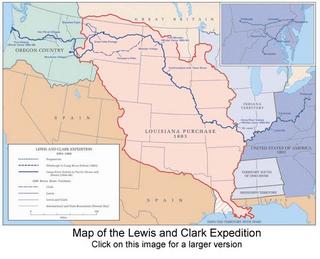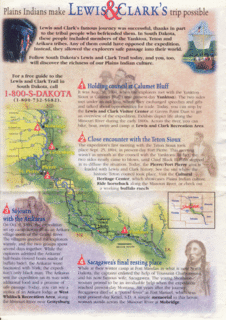Lewis and Clark

Travel the time linechronologically or jumpdirectly to a year below.
January 18, 1803U.S. President Thomas Jefferson sends a secret message to Congress asking for approval and funding of an expedition to explore the Western part of the continent.
Spring 1803Meriwether Lewis begins his training as the expedition's leader in Philadelphia.
July 4, 1803News of the Louisiana Purchase is announced; Lewis will now be exploring land largely owned by the United States.
Summer 1803In Pittsburgh, Lewis oversees construction of a keelboat, then picks up William Clark and other recruits as he travels down the Ohio River.
Fall/Winter 1803Lewis and Clark establish Camp Wood, the winter camp for their Corps of Discovery, on the Wood River in Illinois.
March 10, 1804Lewis and Clark travel to St. Louis to attend ceremonies formally transferring the Louisiana Territory to the United States.
May 14, 1804The Corps of Discovery leaves Camp Wood and begins its journey up the Missouri River "under a gentle breeze."
July 4, 1804The Corps holds the first Independence Day celebration west of the Mississippi River.
August 3, 1804North of present-day Omaha, Nebraska, the Corps holds a council with the Oto and Missouri Indians.
August 20, 1804Sergeant Charles Floyd dies of natural causes near present-day Sioux City, Iowa; he will be the only fatality among the Corps of Discovery during the expedition.
August 30, 1804The Corps holds a council with the Yankton Sioux at present-day Yankton, South Dakota.
Early September 1804The Corps enters the Great Plains and sees animals unknown in the eastern United States.
September 25, 1804The Corps has a tense encounter with the Teton Sioux near today's Pierre, South Dakota; one of the Sioux chiefs waves his men off and conflict is averted.
October 24, 1804Near today's Bismarck, North Dakota, the Corps arrives at the villages of the Mandan and Hidatsa, buffalo-hunting tribes that live along the Missouri River.
November 4, 1804Lewis and Clark hire French-Canadian fur-trader Toussaint Charbonneau and his Shoshone wife, Sacagawea, to act as interpreters on the journey ahead.
December 17, 1804The men record the temperature at 45 degrees below zero, "colder than [they] ever knew it to be in the States."
December 24, 1804The men finish building Fort Mandan, their winter quarters in present-day North Dakota.
January 1805The Corps attends a Mandan buffalo dance, performed to call buffalo to the area.
February 11, 1805Sacagawea's son, Jean Baptiste Charbonneau—nicknamed Pompy by Clark—is born with assistance from Lewis.
April 7, 1805Lewis and Clark send a shipment of artifacts and specimens to President Jefferson; the "Permanent Party" heads west.
April 29, 1805The Corps marvels at the abundance of game; they kill their first grizzly bear near the Yellowstone River in Montana.
May 16, 1805One of their boats nearly overturns and Lewis credits Sacagawea with saving their most important possessions.
May 31, 1805The Corps reaches the White Cliffs region of the Missouri River.
June 1, 1805The Corps reaches an unknown fork in the Missouri and must determine which branch to choose.
June 13, 1805Lewis reaches the Great Falls of the Missouri—five massive cascades around which the men must carry all of their gear, including the canoes.
Late July 1805The expedition reaches the Three Forks of the Missouri which they name the Jefferson, Gallatin, and Madison in honor of the President, Secretary of the Treasury, and Secretary of State.
August 8, 1805Sacagawea recognizes Beaverhead Rock and knows they are close to Shoshone lands.
August 12, 1805Jefferson receives the shipment from Fort Mandan; Lewis finds the headwaters of the Missouri River, then crosses the Continental Divide and Lemhi Pass to discover that there is no Northwest Passage.
August 17, 1805The main party arrives at the Shoshone camp, where Sacagawea recognizes the chief as her long-lost brother, Cameahwait.
August 18, 1805Lewis' celebrates his 31st birthday and vows "in future, to live for mankind as I have heretofore lived only for myself."
August 31, 1805The expedition sets out for the Bitterroot Mountains with many horses and a mule acquired from the Shoshone.
September 9, 1805The men camp near today's Missoula, Montana at a spot they name Traveler's Rest while they prepare for the mountain crossing to come.
September 11, 1805The Corps begins the steep ascent into the Bitterroot Range of the Rocky Mountains; the crossing will cover more than 160 miles (260 kilometers).
September 23, 1805Starving, the men emerge from the mountains near present-day Weippe, Idaho, at the villages of the Nez Perce Indians.
October 7, 1805After learning a new method to make dugout canoes from the Nez Perce, the men push off down the Clearwater River near Orofino, Idaho; it is the first time they've traveled with the current at their back in almost two years.
October 16, 1805The expedition reaches the Columbia River, the last waterway to the Pacific Ocean.
Late October 1805The Corps must run their canoes through treacherous rapids at The Dalles and Celilo Falls.
November 7, 1805Believing he sees the Pacific, Clark writes, "Ocian in View! O the joy." In reality, they are seeing only the widening estuary of the Columbia River.
November 24, 1805Having reached the Pacific, the entire expedition—including Sacagawea and Clark's slave, York—take a vote on where to build their winter quarters. They chose the Clatsop Indian side of the Columbia, and the encampment came to be called Fort Clatsop.
March 23, 1806After a winter of only 12 days without rain, the men present their fort to the Clatsop Indians and set out for home.
September 23, 1806Having found an easier route across the country, the men reach St. Louis nearly two and a half years after their journey began and are acclaimed as national heroes




http://www.discoveringmontana.com/MHSWeb/lewisandclark/css/research/imagegallery.asp
THIS HAS SOME FANTASTIC ART WORK DEPICTING LEWIS AND CLARKS JOURNEY THROUGH MONTANA
http://www.sdhistory.org/Exhibit1/mus_lcx.htm
THIS SITE DISCUSSES LEWIS AND CLARK IN SOUTH DAKOTA


0 Comments:
Post a Comment
<< Home